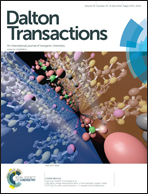CuII complexes with co-planar [CuII(N–N)(HIMC−)], their anti-cancer activities, ΔG, ΔE and solid luminescence†
Abstract
[CuII(phen)(HIMC−)(H2O)]·[CuII(phen)(HIMC−)(NO3−)]·NO3−·H2O (1) and [CuII(2,2′-bipy)(HIMC−)]·NO3−·xH2O (2) (phen = 1,10-phenanthroline, 2,2′-bipy = 2,2′-bipyridine, HIMC− = 1H-imidazole-4-carboxylate acid anion) have been synthesized at 180 °C, of which the HIMC− is produced by an in situ decarboxylation from H3IDC (1H-imidazole-4,5-dicarboxylic acid) in a one-pot hydrothermal reaction. The anticancer activity experiments in vitro show that 1 exhibited excellent activities against A549, Bel-7402 and HCT-8 cancer cells and is even better than the clinical anticancer drug 5-Fu (5-fluorouracil), while 2 shows little response toward the cancer cells. The single crystal X-ray diffraction indicated that complex 1 possess a co-planar [CuII(N–N)(HIMC−)] coordination geometry. The IR, elemental analysis and solid-state luminescent spectra of complexes 1 and 2 indicated that the composition of these two complexes are similar, whereas the 2,2′-bipy in complex 2 replaced phen in complex 1. The calculation by the Gaussian 03 program illustrated that the decrease in the energy gaps between π*–π from the free to the coordinated ligand for 2,2′-bipy and phen (ΔE) are 5.3 eV to 4.0 eV and 4.8 eV to 4.5 eV separately, and the relative changes of the Gibbs free energies (ΔG) for complex 1 and 2 decomposing into free Cu2+ and ligands are about 0 kcal mol−1 and 7 kcal mol−1 respectively, which revealed that it is more stable when 2,2′-bipy is coordinated with CuII than phen, and 1 is easier to disassociate into free Cu2+ than 2. By relating the ΔE, ΔG, luminescent qualities and anticancer toxicities of the complexes with their composition, it can be concluded that both CuII and their coordinated ligands are responsible for the inhibition against cancer cells.
![Graphical abstract: CuII complexes with co-planar [CuII(N–N)(HIMC−)], their anti-cancer activities, ΔG, ΔE and solid luminescence](/en/Image/Get?imageInfo.ImageType=GA&imageInfo.ImageIdentifier.ManuscriptID=C3DT53221F&imageInfo.ImageIdentifier.Year=2014)

 Please wait while we load your content...
Please wait while we load your content...